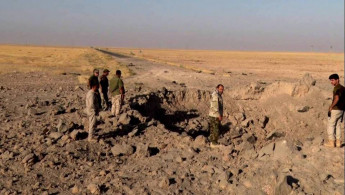Exclusive photos: Syria-bound Iranian ballistic missiles fall in Iraq
Iran's elite Revolutionary Guards Corps were deployed to recover wreckage from four Iranian ballistic missiles on Wednesday that missed their targets in Syria and fell in Iraq's western desert region.
2 min read
The pictures show alleged debris and craters from the Iranian rockets [TNA]
A special unit from Iran's crack Revolutionary Guards Corps (IRGC) operating in Iraq was deployed on Wednesday night to recover wreckage of four Iranian ballistic missiles that had fallen in western Iraq, Baghdad officials and members of the Popular Mobilisation Forces militias told The New Arab.
The missiles fired from Iran into Syria's Deir ez-Zor province on June 18 allegedly failed to reach their targets, falling across scattered parts of the al-Baaj desert west of Mosul.
Iran at the time said the missile strikes were successful, denying reports that four out of six missiles fired at Islamic State targets in eastern Syria had missed.
Analysts at the time said the Tehran failed in their show of force and the Iranian-made Zolfaqar missiles were a "flop".
Four missiles fell in Tal Abta, Addayah and the Baaj desert west of Mosul, including one that fell close to a base run by Saraya al-Jihad of the PMF, a high-level Iraqi official told The New Arab's correspondent in Iraq. No casualties were reported.
The IRGC unit deployed on Wednesday night removed the missile parts and transported them to an undisclosed location, the official added.
Pictures leaked by PMF members to The New Arab show what appears to be a large crater and missile debris. The New Arab was not able to independently verify their authenticity.
PMF members said the IRGC used small trucks to haul away the wreckage of the Iranian missiles.
"One of them appears to be unexploded, and had been buried in the area of Tal Abta near a cattle barn," Nasser Hussein, a self-identified PMF member, told The New Arab.
Iran on 18 June said it fired six ballistic missiles at IS targets in Syria in retaliation for an attack in Tehran staged by the terror group.
The missiles fired from Iran into Syria's Deir ez-Zor province on June 18 allegedly failed to reach their targets, falling across scattered parts of the al-Baaj desert west of Mosul.
Iran at the time said the missile strikes were successful, denying reports that four out of six missiles fired at Islamic State targets in eastern Syria had missed.
Analysts at the time said the Tehran failed in their show of force and the Iranian-made Zolfaqar missiles were a "flop".
Four missiles fell in Tal Abta, Addayah and the Baaj desert west of Mosul, including one that fell close to a base run by Saraya al-Jihad of the PMF, a high-level Iraqi official told The New Arab's correspondent in Iraq. No casualties were reported.
The IRGC unit deployed on Wednesday night removed the missile parts and transported them to an undisclosed location, the official added.
Pictures leaked by PMF members to The New Arab show what appears to be a large crater and missile debris. The New Arab was not able to independently verify their authenticity.
Article continues below
 |
| Massive creater allegedly from an Iranian ballistic missile [TNA] |
PMF members said the IRGC used small trucks to haul away the wreckage of the Iranian missiles.
"One of them appears to be unexploded, and had been buried in the area of Tal Abta near a cattle barn," Nasser Hussein, a self-identified PMF member, told The New Arab.
Iran on 18 June said it fired six ballistic missiles at IS targets in Syria in retaliation for an attack in Tehran staged by the terror group.
Some hours later, Saraya al-Jihad, a Tehran-backed militia operating in western Iraq, said its forces came under a rocket attack from an unknown source on the road linking Tal Abta and Addaya, without reporting any casualties.
In a statement, the militia said the rockets caused a 12-metre wide crater, with debris scattered across an area of 800 metres.
 |
| Alleged debris from the Iranian ballistic missiles [TNA] |





 Follow the Middle East's top stories in English at The New Arab on Google News
Follow the Middle East's top stories in English at The New Arab on Google News
![The UAE is widely suspected of arming the RSF militia [Getty]](/sites/default/files/styles/image_330x185/public/2024-11/GettyImages-472529908.jpg?h=69f2b9d0&itok=Yauw3YTG)
![Netanyahu furiously denounced the ICC [Getty]](/sites/default/files/styles/image_330x185/public/2024-11/GettyImages-2169352575.jpg?h=199d8c1f&itok=-vRiruf5)
![Both Hamas and the Palestinian Authority welcomed the ICC arrest warrants [Getty]](/sites/default/files/styles/image_330x185/public/2024-11/GettyImages-2178351173.jpg?h=199d8c1f&itok=TV858iVg)